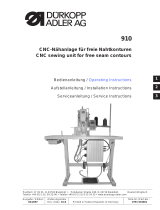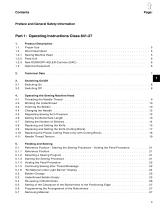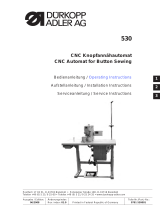
1. Product description
The Dürkopp Adler 540-100-1 is a CNC double lockstitch buttonhole
machine with stepping motor technology for the sewing of flat form
linen button holes in light to medium weight material. Maximum
buttonhole length is 65 mm and maximum buttonhole width is 6 mm
(equipment dependent).
Including a knife for all cutting lengths, longitudinal or transversal
setting possible, fine adjustment of the buttonhole with the push of a
button, integrated direct DC drive.
Additional functions:
–
Selectable bartack forms :
Cross tack (vertical), Cross tack (horizontal), Cross tack (divided),
Round tack (to the middle point), Round tack (horizontal), Taper
tack, Eye tack, Simple tack, Snaffle-shaped tack
–
50 variable s eam makers
–
20 Buttonhole – each s equence can be programmed with a
maximum of 20 buttonholes
–
Programmable sewing revolution to a max. of 4000 stitches/min
–
Soft start
–
Bobbin capacity meter
–
Daily quantity meter
–
Multi test functions
–
Voltage rating: 1 x 190 - 240V 50/60Hz
1.1 Designated use
The DÜRKOPP ADLER 540-100-1 is an automatic sewing machine
designed for sewing buttonholes in light to medium-heavy material.
Such material, which is generally made of textile or synthetic fibres, is
used in the clothing industry. This sewing machine can also be used to
produce so-called technical seams. In this case, however, the operator
must assess the possible dangers which may arise (with which
DÜRKOPP ADLER would be happy to assist), since such applications
are on the one hand relatively unusual and, on the other, they are so
varied that no single set of criteria can cover them all. The outcome of
this assessment may require appropriate safety measures to be taken.
Generally only dry material may be sewn with this machine. The
material may be no thicker than 4 mm when compressed by the
lowered upper material sewing basket.
The material may not contain any hard objects. The machine may only
be operated with finger and eye protection. The seam is generally
produced with sewing threads of gauge up to 65/2 Nm (synthetic
threads with or without cotton covering). Before using any other thread
the possible dangers arising must be assessed and appropriate safety
measures taken if necessary. This machine may be set up and
operated only in dry, well-maintained premises. If it is used in other
premises which are not dry and well-maintained it may be necessary
to take further precautions (which should be agreed in advance - see
EN 60204-31: 1999). As manufacturers of industrial sewing machines
we proceed on the assumption that personnel who work on our
products will have r eceived training at least s ufficient to acquaint them
with all normal operations and with any hazards which these may
involve.



























